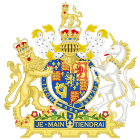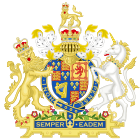England and United Kingdom Stamp Acts
Stamps Act 1694
| Stamps Act 1694 | |
|---|---|
| Act of Parliament | |
 | |
| Long title | An Act for granting to theire Majesties severall Dutyes upon Velum Parchment and Paper for Four Yeares towards carryyng on the warr against France. |
| Citation | 5 & 6 Will. & Mar. c. 21 |
| Dates | |
| Royal assent | 25 April 1694 |
| Commencement | 28 June 1694 |
| Repealed | 1 January 1871 |
| Other legislation | |
| Amended by | Stamps (Amendment) Act 1694 |
| Repealed by | Inland Revenue Repeal Act 1870 |
Status: Repealed | |
| Text of statute as originally enacted | |
| Stamps (Amendment) Act 1694 | |
|---|---|
| Act of Parliament | |
 | |
| Long title | An Act for explaineing and regulateing several Doubts Duties and Penalties in the late Act for granting several Duties upon Velum Parchment and Paper and for ascertaineing the Admeasurement of the Tunnage of Ships. |
| Citation | 6 & 7 Will. & Mar. c. 12 |
| Dates | |
| Royal assent | 22 April 1695 |
| Repealed | 1 January 1871 |
| Other legislation | |
| Amends | Stamps Act 1694 |
| Repealed by | Inland Revenue Repeal Act 1870 |
Status: Repealed | |
| Text of statute as originally enacted | |
| Stamps Act 1697 | |
|---|---|
| Act of Parliament | |
 | |
| Long title | An Act for granting to His Majesty His Heires & Successors further Duties upon Stampt Vellum Parchment. & Paper. |
| Citation | 9 Will. 3. c. 25 (Ruffhead: 9 & 10 Will. 3. c. 25) |
| Dates | |
| Royal assent | 5 July 1698 |
| Repealed | 1 January 1871 |
| Other legislation | |
| Repealed by | Inland Revenue Repeal Act 1870 |
| Relates to |
|
Status: Repealed | |
| Text of statute as originally enacted | |
| Stamps Act 1702 | |
|---|---|
| Act of Parliament | |
 | |
| Long title | An Act for preventing Frauds in Her Majesty's Duties upon stampt Vellum, Parchment, and Paper. |
| Citation | 1 Ann. St. 2. c. 19 (Ruffhead: c. 22) |
| Dates | |
| Royal assent | 27 February 1703 |
| Repealed | 1 January 1871 |
| Other legislation | |
| Repealed by | Inland Revenue Repeal Act 1870 |
Status: Repealed | |
| Stamps Act 1709 | |
|---|---|
| Act of Parliament | |
 | |
| Long title | An Act for laying certain Duties upon Candles, and certain Rates upon Monies to be given with Clerks and Apprentices, towards raising Her Majesty's Supply, for the Year One Thousand Seven Hundred and Ten. |
| Citation | 8 Ann. c. 5 (Ruffhead: c. 9) |
| Dates | |
| Royal assent | 24 March 1710 |
| Repealed | 1 January 1871 |
| Other legislation | |
| Repealed by | Inland Revenue Repeal Act 1870 |
Status: Repealed | |
| Stamps Act 1710 | |
|---|---|
| Act of Parliament | |
 | |
| Long title | An Act for making good Deficiencies, and satisfying the Public Debts; and for erecting a Corporation to carry on a Trade to The South Seas; and for the Encouragement of the Fishery; and for Liberty to trade in unwrought Iron with the Subjects of Spain; and to repeal the Acts for registering Seamen. |
| Citation | 9 Ann. c. 15 Ruffhead c. 21 |
| Dates | |
| Royal assent | 12 June 1711 |
| Repealed | 1 January 1871 |
| Other legislation | |
| Repealed by | Inland Revenue Repeal Act 1870 |
Status: Repealed | |
| Stamps (No. 2) Act 1710 | |
|---|---|
| Act of Parliament | |
 | |
| Long title | An Act for licensing and regulating Hackney Coaches and Chairs; and for charging certain new Duties on Stamped Vellum, Parchment, and Paper, and on Cards and Dice, and on the Exportation of Rock Salt for Ireland; and for securing thereby, and by a Weekly Payment out of the Post-office, and by several Duties on Hides and Skins, a Yearly Fund of One Hundred Eighty-six Thousand Six Hundred and Seventy Pounds, for Thirty-two Years, to be applied to the Satisfaction of such Orders as are therein mentioned, to the Contributors of any Sum, not exceeding Two Millions, to be raised for carrying on the War, and other Her Majesty's Occasions. |
| Citation | 9 Ann. c. 16 Ruffhead c. 23 |
| Dates | |
| Royal assent | 12 June 1711 |
| Other legislation | |
| Repealed by | Inland Revenue Repeal Act 1870 |
Status: Repealed | |
A stamp duty was first introduced in England in 1694 following the Dutch model as An act for granting to Their Majesties several duties on Vellum, Parchment and Paper for four years, towards carrying on the war against France (5 & 6 Will. & Mar. c. 21). [5] The duty ranged between 1 penny to several shillings on a number of different legal documents including insurance policies, documents used as evidence in courts, grants of honour, grants of probate and letters of administration. It raised around £50,000 a year and although it was initially a temporary measure, it proved so successful that its use was continued.
Stamp Act 1712
| Stamp Act 1712 | |
|---|---|
| Act of Parliament | |
 | |
| Long title | An Act for altering the Stamp Duties upon Admissions into Corporations or Companies; and for further securing and improving the Stamp Duties in Great Britain. |
| Citation | 10 Ann. c. 18 (Ruffhead: c. 19) |
| Dates | |
| Commencement | 5 July 1765 |
| Repealed | 1 July 1855 |
Status: Repealed | |
| Stamps Act 1713 | |
|---|---|
| Act of Parliament | |
 | |
| Citation | 13 Ann. c. 18 (Ruffhead: 12 Ann. St. 2 c. 9) |
| Other legislation | |
| Repealed by | Inland Revenue Repeal Act 1870 |
Status: Repealed | |
The Stamp Act 1712 was an act passed in the United Kingdom on 1 August 1712 to create a new tax on publishers, particularly of newspapers. [6] [7] [8] The initial assessed rate of tax was one penny per whole newspaper sheet, a halfpenny for a half sheet, and one shilling per advertisement contained within. [9] Other than newspapers, it required that all pamphlets, legal documents, commercial bills, advertisements, and other papers be issued the tax. [10] The act was increased in 1797 with greater taxes and wider spectrum of materials affected, reached its height around 1815 during the "taxes on knowledge" struggle, reduced in 1836, and repealed in 1855. [11]
The stamp tax was a tax on each newspaper and thus hit cheaper papers and popular readership harder than wealthy consumers, because it formed a higher proportion of the purchase price. The act had a chilling effect on publishers; the tax is blamed for the decline of English literature critical of the government during the period, notably with The Spectator ending the same year of the tax's enactment. [12] Its repeal in 1855 allowed a cheap press again.
Stamp Duties Management Act 1891 and Stamp Act 1891
| Stamp Duties Management Act 1891 | |
|---|---|
| Act of Parliament | |
 | |
| Long title | An Act to consolidate the Law relating to the Management of Stamp Duties. |
| Citation | 54 & 55 Vict. c. 38 |
| Dates | |
| Royal assent | 21 July 1891 |
| Other legislation | |
| Repeals/revokes | |
Status: Amended | |
| Text of statute as originally enacted | |
| Text of the Stamp Duties Management Act 1891 as in force today (including any amendments) within the United Kingdom, from legislation.gov.uk. | |
| Stamp Act 1891 | |
|---|---|
| Act of Parliament | |
 | |
| Long title | An Act to consolidate the Enactments granting and relating to the Stamp Duties upon Instruments and certain other enactments relating to Stamp Duties. |
| Citation | 54 & 55 Vict. c. 39 |
| Dates | |
| Royal assent | 21 July 1891 |
| Other legislation | |
| Repeals/revokes | |
Status: Amended | |
| Text of statute as originally enacted | |
| Text of the Stamp Act 1891 as in force today (including any amendments) within the United Kingdom, from legislation.gov.uk. | |
All the above Acts were superseded by the Stamp Duties Management Act 1891 and the Stamp Act 1891, which still constitute the bulk of UK law on stamp duties today.
The modern UK Stamp Act
From 1914 to 1928, the Director of Stamping at the Stamp Office oversaw the production of Treasury Notes (a type of banknote, not to be confused with US Treasury notes). These were issued for denominations of £1 and 10's to enable coins to be removed from circulation and were not convertible to gold. Existing Bank of England banknotes in higher denominations continued to circulate alongside the Treasury Notes. In 1963 production of postage stamps passed to the General Post Office.
The Finance Act 1986 introduced Stamp Duty Reserve Tax. From October 27, 1986, the charge was imposed on 'closing' transactions at the London Stock Exchange which until then had been transactions where no document was used and therefore exempt from Stamp Duty.
A public display of Stamp Office artifacts and records was held at the Courtauld Institute in 1994 to commemorate the three hundredth anniversary of the introduction of UK Stamp Duty. The Stamp Office was also awarded the Charter Mark by John Major's Advisory Committee as a reward for its public service.
Stamp duties are the oldest taxes still raised by the HM Revenue and Customs.









